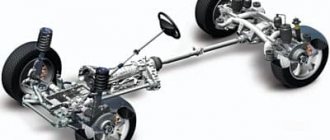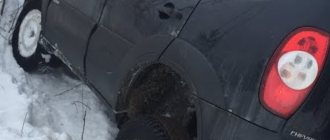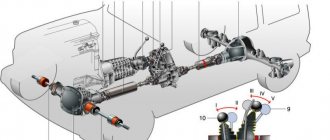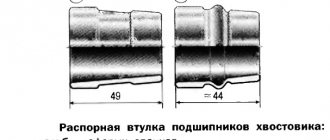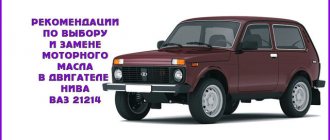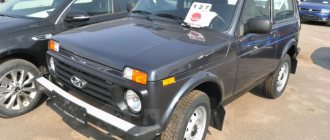Rate this post
Lada 4×4 is a full-fledged SUV from the domestic automobile industry, which began to be produced back in the 70s of the last century. This car has become a faithful companion for lovers of off-road travel; it attracts with its affordable price, unpretentiousness and compact size. The follower of the Lada4×4 was the Chevrolet Niva; it is still assembled at the plant in Tolyatti. It features a more modern interior and exterior, but retains excellent cross-country ability and all-wheel drive transmission. Let's look at how the Lada 4×4 and Chevrolet Niva all-wheel drive is designed and how it behaves in different road conditions.
Niva drive device
The chassis of the car is made on the principle of permanent all-wheel drive - torque from the power unit is transmitted to all 4 wheels. This scheme improves the performance of the car when driving in off-road conditions, while simultaneously reducing the load on transmission parts.
The Chevrolet Niva drive consists of the following components:
- Gearbox.
- Transfer case.
- A pair of drive and cardan shafts.
- Front and rear axle gearboxes.
The transfer case is designed to distribute torque between the drive axles of the vehicle. The car is equipped with a two-speed transfer case, which provides:
- stable running of the machine when driving at low speed and at high engine speeds;
- power distribution between drive axles, depending on road grip.
The differential is one of the most important elements of the transmission. Its main purpose is to distribute traction force, and, if necessary, ensure rotation of two consumers at different angular speeds. The Chevrolet Niva drive transmission has three differentials:
- One for each axle (interwheel) - enable the wheels of the same axle to rotate at different speeds.
- The third (interaxle action) - transmits power from the power unit to both axles of the vehicle. It also allows the shafts to operate at different angular speeds, depending on operating conditions, which significantly improves controllability.
A pair of cardan shafts (CV joint or cross design) provide connection between the transfer case and the drive axle gearboxes. Both car shafts have the same design - they are interchangeable.
Transfer case
The transfer case and differential control lever (multiplier) allows you to combine one of two modes with turning on or off the center lock. Together with neutral, there are 5 lever positions.
- Neutral position. There is no engagement in the main pair. The car cannot move.
- Differential unlocked, reduction disabled. Essentially, this is normal mode for everyday driving. The distribution of the moment of force occurs in a ratio of 1:2.
- Differential locked, reduction disabled. The distribution of the moment of force between the axles occurs in equal shares, but due to the operation of the cross-axle differential, the force on each wheel depends on the road surface.
- Differential is unlocked and reduction is engaged. The torque has been increased, but its distribution between the axles is 1:2.
- Differential locked, reduction enabled. Bridges work in a rigid connection. The car has the most increased cross-country ability.
The principle of operation of all-wheel drive on a Chevrolet Niva
In normal mode, the Chevrolet Niva operates in high gear with the differential unlocked. Torque is transmitted from the power unit, through the gearbox and intermediate shaft, to a two-stage transfer case gearbox. A center differential is installed in the transfer case housing. It links the front and rear axles, allowing them to rotate at different speeds, depending on road conditions and direction of travel.
How does all-wheel drive work on a Niva with a locked differential?
When all-wheel drive is engaged, both cardan shafts are secured with a locking clutch. This promotes uniform transmission of traction force to both axles of the vehicle. Due to this, the vehicle's cross-country ability increases, but controllability deteriorates.
Advice: It is not recommended to use the lock mode on roads with good grip, as this will lead to accelerated tire wear, increased load on transmission parts and components, and will also increase fuel consumption.
Nivov transmission units
The developed Niva transmission turned out to be so successful and efficient that it later became a prototype for the Vitara. This made the new model more adaptable to difficult roads. Niva transmission units can easily meet the requirements of any engine up to 2 liters, so if you want to upgrade, think about the fact that each car has its own capabilities. Many advantages are due precisely to the circuit and design of the transmission.
Niva transmission and its components:
- front-wheel drive;
- front axle;
- wheel grip;
- manual transmission;
- driveshaft (front);
- shaft (intermediate);
- transfer case;
- shift lever;
- center differential and locking lever;
- wheel differentials;
- driveshaft (rear);
- rear axle;
- rear drive.
The design implies the following states:
- unlocked differential;
- locked differential;
- low gear when engaged;
- neutral position;
- top gear engaged.
How to turn on all-wheel drive
Since the drive on the Niva is constantly all-wheel drive, the question of how to turn on the all-wheel drive on the Niva Chevrolet means how to turn on the center differential lock.
You need to use blocking in the following cases:
- when driving in difficult terrain where there is a danger of wheel slipping;
- when there is a lack of engine thrust;
- when driving on a road covered with snow or ice.
Important: Blocking is useless when the car is hung diagonally, when one wheel on different axles begins to slip. This is due to the design feature of the transmission. In this case, you need to act according to the situation - dig up or pour under the hanging wheels.
The main component of the axle locking mechanism is the transfer case. The transfer case is controlled by one six-position lever. The longitudinal stroke provides higher and lower gear rows. Transverse - responsible for locking the center differential. When the lever is in lock mode, a yellow icon lights up on the instrument panel. There are no synchronizers in the design of the transfer case, therefore, when you try to engage the speed range or lock, the gears clash tooth to tooth. To switch, you just need to move the car forward or backward and then everything will switch.
Recently, SUVs and crossovers with all-wheel drive have become very popular. If previously preference was given only to cars with high ground clearance, now the presence of a 4x4 transmission is a priority.
But such technology can be implemented in completely different ways; let’s look at the structural features of the center lock and clutch on a Chevrolet Niva car.
Main problems with the range multiplier
The main function of the range multiplier has the properties of a gearbox divider; it turns them on or off the gear speed.
Most transfer case breakdowns are purely mechanical in nature (for example, a cut shaft between the gearbox and the transfer case). This is provoked by inattention to fuel and lubricant levels, wear of rubber bands, incorrect location (alignment) of the unit, and the condition of adjacent components. The first indicator of problems with the transfer case is characteristic noise and vibration in the body.
Vibration when driving on Niva
The first reason is that at a speed of more than 70 km per hour, it’s all about the cardan shaft; only the original one must be installed. Next, replace the crosspiece on the cardan shaft, after which you must drag the shaft to a stand and balance it, otherwise the vibration will resume.
The second reason for vibration is the intermediate shaft, it must also be original, otherwise it will quickly fail. We take only the original AvtoVAZ one from the factory, otherwise vibration and breakdowns cannot be avoided.
The third reason for vibration is the breakdown of the gearbox flange bearings. To eliminate the problem, place additional support on the gearbox.
How to overcome noise when maneuvering in a transfer case
You can buy new handles for the levers. We change it ourselves, prying up the support with a screwdriver, take out the lever axis and get rid of the old handles. We remove the old lever springs and install new ones. Insert the lever axis and secure it with a corkscrew nut. Now, when driving with the new handles, there is no characteristic noise in the cabin. The handles can be easily changed without leaving the salon.
Stiff switching of the lock lever
This issue can be easily solved in the following way: when driving, just turn the steering wheel slightly and the lock will immediately turn on without any problems.
There are also: jamming of the pneumatic cylinder, sticking in the neutral position, or the rod is sitting tightly. Burnt gear and shift fork.
Transfer case for Niva, signs of breakdowns:
- problematic engagement of the front axle;
- overheating of the range multiplier;
- leakage or excessive consumption of oil during operation of the transfer case;
- self-switching of the front axle.
Repairing the transfer case in Niva 21213 with your own hands is quite possible in case of minor breakdowns. The owner of a Chevy Niva will only need the basic skills of a car mechanic. It is more difficult to correctly install and center the Niva transfer case. Here it is still recommended to contact a car service. A diagram of the unit itself is presented in the vehicle documentation.
Drive device.
The classic Niva 2121 became the first Russian SUV to be equipped with an all-wheel drive transmission. Among the main features of this transmission was the ability to lock the center differential. Many people mistakenly believe that this unit is necessary to connect the front axle. But in reality, the front axle is always in the connected position. Let's try to understand the design of the car in more detail.
The chassis of the car is designed in such a way that torque from the engine is transmitted through the gearbox to all 4 wheels at once. This operating scheme allows you to show the best performance when moving off-road, while at the same time significantly reducing the cost of the main parts.
Main transmission components:
- Gear box,
- Razdatka,
- Drives and cardan shafts,
- Front and rear gearboxes.
It is the transfer case in the car that is responsible for distributing torque between the axles. On the Chevrolet Niva it is two-speed and its presence provides the following advantages:
- Smooth vehicle movement at low speeds at high engine speeds.
- Distribution of forces between the axles of the car depending on specific road conditions.
The differential is necessary to distribute traction forces. In practice, this allows two wheels to rotate on the same axis at different speeds. The Chevrolet Niva has 3 differentials, which allows each wheel to have its own angular velocity.
Cardan shafts are necessary to connect transfer cases and axle gearboxes. Chevrolet Niva shafts have one interesting feature: they have exactly the same design, as a result of which they are interchangeable and if one of them fails, if necessary, you can sacrifice all-wheel drive, but get to the nearest service station yourself.
The axles are equipped with internal hinges that transmit force from the transfer case to the drive wheels.
Transmission
The Chevrolet Niva gearbox has no structural differences compared to the Lada 4x4 box, and they are identical in design. The difference can only be noticed in the mounting and length of the gear shift drive. Another important feature is the presence of 5th gear.
The main parameter of the gearbox is the gear ratio. By trivial definition, this is the ratio of the number of teeth of the driven shaft to the number of teeth of the drive shaft. Naturally, we talk about the gear ratio when there is actually a transfer of torque from one shaft to another. If the specified parameter is greater than 1, then such a mechanism works to increase torque. The gear ratio for IV gear is 1, and for V – 0.82. That is, in V gear there will be an increase in the number of revolutions of the secondary shaft with a parallel decrease in torque. It is more convenient to imagine the value of the gear ratio using the sprockets of a high-speed bicycle.
Operating principle of the drive.
By default, the SUV uses high gear with the center differential disabled. The engine transmits force to the gearbox, which is fed through the shaft to the transfer case gearbox. The transfer case contains a center differential, which connects the front and rear axles.
How does all-wheel drive work on a Chevrolet Niva if the differential is locked.
If you turn on all-wheel drive on the Niva, the cardan shafts will be blocked using a special clutch. In this case, there will be an even distribution of torque between the axles. The vehicle's cross-country ability will increase significantly, but at the same time, handling will become slightly worse.
Differential locking
Sometimes you can come across a misconception about why a small handle is needed next to the shift lever on a Niva. Some car owners believe that it is needed to connect front-wheel drive. However, the front-wheel drive of this car is permanently connected. As is the rear one. Cars of the Niva family have permanent all-wheel drive. The handle actually serves to switch the operating modes of the differential of the transfer mechanism.
In the “forward” position, the differential operates as usual, but if you move it back, the differential is locked, and the forces from the motor are applied to the differentials of the axles, which makes the drive more rigid. It is worth noting that there are also special types of locks for front and rear axles.
In theory, when used in conditions where the car is stuck, it will be able to overcome the obstacle if there is sufficient traction on at least one wheel. In this case, it is better to lock the differential before overcoming an obstacle, but never after entering an area that is difficult to overcome. This application of locking will avoid wear and damage to the transmission.
Turning on all-wheel drive.
The use of blocking will be justified in the following cases:
- If there is a possibility of wheel slipping, in areas with poor surface conditions,
- If there is a lack of engine thrust at high speeds,
- When driving on roads with loose surfaces, snow, ice.
You should also take into account some features of the Chevrolet Niva, namely, the helplessness of the transmission when hanging diagonally. In this mode, the wheels begin to spin, so if necessary, you need to dig under the wheel or make an embankment under the raised axle.
Lada 4×4 is a full-fledged SUV from the domestic automobile industry, which began to be produced back in the 70s of the last century. This car has become a faithful companion for lovers of off-road travel; it attracts with its affordable price, unpretentiousness and compact size. The follower of the Lada4×4 was the Chevrolet Niva; it is still assembled at the plant in Tolyatti. It features a more modern interior and exterior, but retains excellent cross-country ability and all-wheel drive transmission. Let's look at how the Lada 4×4 and Chevrolet Niva all-wheel drive is designed and how it behaves in different road conditions.
Design features of all-wheel drive Lada 4×4
The Niva transmission has three differentials: two interwheel and one interaxle. This allows the wheels and axles to rotate at different speeds depending on road conditions. When moving uniformly on a flat surface, the force between the wheels is distributed evenly, but when any wheel slips, the rotational motion is redistributed so that the car can continue moving. Under normal road conditions, the vehicle is driven with the differential unlocked.
The presence of a center differential allows you to enjoy all the benefits of all-wheel drive in any road conditions. Cars with rigidly connected all-wheel drive can only be used in single-wheel drive mode on surfaces that do not imply wheel slipping.
The SUV's drive includes a gearbox, transfer case, front and rear drive and cardan shafts, front and rear gearboxes. Two-speed transfer case. Thanks to this, the car can move stably at low speeds at high engine speeds, and also correctly distribute torque under different road conditions.
The front and rear shafts of the vehicle have the same design and are interchangeable. If one of them fails, you can sacrifice all-wheel drive and easily get to the car service center.
Modified versions
The Niva's standard transmission, for all its advantages, often causes uncomfortable noise in the cabin. This is generally related to the design, but using engineering developments, you can modernize it and make the car much quieter.
This approach has already been applied in VAZ-21213 cars; as a result, even at a speed of 100 km/h you don’t feel any unpleasant noise, you can talk calmly and hear your interlocutor without effort. For these purposes, a number of modernization methods have been used: from unloading the floor near the transfer case and manual transmission mounts, reducing the load on shaft bearings to smoothing out peak torques under conditions of increasing loads on the transmission.
The noise in the modernized Niva transmission is comparable to that of a Zhiguli. It becomes more comfortable to be in the car when driving off-road. Upgrade costs are negligible; modification requires only the master's understanding of the design itself and a little time.
How all-wheel drive works on Lada 4×4 and Chevrolet Niva
All-wheel drive on the Niva is permanent. Under normal road conditions, the vehicle drives with the differential unlocked. The differential lock must be turned on when driving on difficult terrain, snow, ice, mud, or when there is a high probability of wheel slipping. If one wheel on the front and rear axles is slipping, locking the differential will not solve the problem; only the suspended wheels will rotate.
The front and rear axles are controlled using a transfer case. The front lever is responsible for engaging the differential lock. By moving the rear handle back and forth, you can engage a lower or higher gear. These controls emphasize that the Lada4×4 and Chevrolet Niva are full-fledged SUVs, and not just cars with four-wheel drive.
The transfer case does not have synchronizers. When shifting, the gears align their teeth to each other; to engage the gear, you need to move the car a little back or forward.
The Niva's front and rear axle differentials are non-locking and redistribute rotational motion automatically. The driver can only lock the center differential.
When the center differential is locked, the same angular velocity is transmitted to the front and rear axles. This increases the vehicle's cross-country ability.
You need to lock the center differential when approaching a difficult section of the road, before the car begins to slip. Mud, sand, snow, ice are surfaces on which the risk of slipping is high; it is better to prepare to overcome such obstacles in advance. When the differential is locked, at least one wheel will rotate on the rear and front axles. But it is worth knowing that if the wheels of the rear and front axles are suspended diagonally or on one side, the differential lock will not solve the problem - the car will not be able to continue moving.
Do not lock the differential on asphalt and other smooth, hard road surfaces. This increases fuel consumption, accelerates tire wear and increases the load on vehicle parts.
Grenade replacement
This unit consists of parts that are constantly in motion. As a result, they may burst or wear out, requiring replacement.
The device can only be repaired if the owner of the car has identified damage to the boot in time, and therefore foreign substances have not yet managed to get inside the mechanism.
But this happens quite rarely, since it is almost impossible to detect damage to the boot in time. It should also be said that the cost of the CV joint is not high, and therefore it can be purchased if necessary.
Troubleshooting
You can determine the malfunction of the grenade yourself. To do this, while the car is moving, turn the steering wheel in any direction until it stops. In this case, the driver will hear a crunching sound in the area of the front wheel. In this case, you need to replace the hinge.
During the repair process, it is important to determine whether it is necessary to change both hinges or one, because such work is recommended to be carried out only in a comprehensive manner
Video on how to determine if a grenade is faulty
Changing a grenade on a Niva Chevrolet with your own hands
To replace a grenade, you must first remove the old one. In the process, you will have to dismantle the axle shaft along with the CV joint (you can find a disassembly video on the Internet). Then the car owner must perform the following actions:
- Clamp the removed assembly in a vice.
- Remove the old boot.
- Knock the CV joint off the axle using a hammer and a socket.
- Clean all teeth on the axle gear.
- Install the new joint on the axle.
- Place the boot and secure it with clamps.
- Install the axle with CV joint on the car.
Tips for operating Lada 4×4 and Chevrolet Niva
Beginners do not immediately remember at what position of the handle the differential is locked. But this is indicated by a warning indicator on the dashboard. If it lights up, the differential is locked. The front handle of the transfer case is responsible for locking the differential. If it is in the forward position, the differential is unlocked, in the rear it is locked.
The rear handle allows you to engage a lower gear. This must be done before getting into difficult road conditions. Since the box does not have synchronizers, switching must be done when the car is stationary. In this case, you need to depress the clutch. If the switch does not occur, you need to slowly move away, shaking the steering wheel.
When driving on a flat road, the rear transfer case handle should be in the rear position, and the front handle should be in the forward position.
What to do if the front and rear wheels are hanging out? As mentioned above, even locking the differential will not help solve this problem; the car will not move. To set the car in motion, you can pour soil under one of the hanging wheels. If there are passengers in the car, you can move them to the rear or front of the car by loading one of the axles.
Eliminate vibration with additional fasteners
Installing the third support of the transfer case on VAZ 21213/21214 vehicles allows you to reduce the level of vibration of the transfer case; with this support it is easier to center the transfer case. The part can be purchased at auto stores or made yourself. The finished product comes with three long studs (for model 2121); to install the third support on this machine, you will need to unscrew the short studs from the transfer case housing and install new studs from the kit. We carry out repairs as follows:
- dismantle the front passenger seat in the cabin;
- remove the floor tunnel lining;
- in the cabin we move aside the carpet covering the body amplifier (in front of the handbrake lever);
Vibration is eliminated more effectively by installing a subframe under the transfer case. You can also make such a device yourself or buy a finished product at a car store.
In order to install the subframe, the transfer case must be removed. It is more convenient to carry out such work in a pit; we carry out repairs as follows:
- leave the car in neutral gear;
- disconnect the propeller shaft from the transfer case, it is advisable to mark the driveshaft flange and the drive shaft so that during installation, align the driveshaft according to the marks - this way, the occurrence of unnecessary vibrations is eliminated;
- dismantle the muffler mounting bracket;
- remove the gearbox traverse;
- jack up the transfer case, remove the side fastenings of the transfer case;
It should be noted that installing an additional support or subframe on the steering wheel does not always lead to the desired effect; in some cases, vibration only increases.
Advantages of Lada 4×4 and Chevrolet Niva cars
Why have these inconspicuously designed cars remained so popular over the years? The secret is the relatively low cost, which is combined with good maneuverability, reliability and simplicity of design. Many people appreciated this vehicle during trips to hunting, fishing, and off-road travel.
Of course, Lada4×4 and Chevrolet Niva have many disadvantages. They are inferior in many respects to modern SUVs, which are distinguished by increased comfort and the presence of many additional options, but for those who are looking for an inexpensive, easy-to-repair car with high cross-country capability, the Niva is a pretty good option.
Lada 4×4
Chevrolet Niva
Location of levers on Lada 4×4
Transmission units
Differential locations
edit this post
The relatively complex scheme for distributing torque from the internal combustion engine to the wheels is explained by the universal purpose of the Niva 2121 - if used correctly, it can be used comfortably in the city and along muddy country roads. Such properties are ensured by the presence of a transfer case with a center differential lock, complementing a 4- or 5-speed manual transmission, depending on the year of manufacture. The lever, located closer to the dashboard , is responsible for turning off/on the center differential, the second “small” lever controls the range multiplier and has 3 positions: high and low rows, as well as neutral.
Design and principle of operation of the Niva 2121 transfer case
The transfer case mechanism includes more than 60 independent parts, which is confirmed by the presented drawing. Therefore, it is quite prudent to name the main elements and their purpose.
Photo No. 1
A pair of gears are tightly seated on the drive shaft, one of them (large) is intended for high gear, the second (small) is responsible for low gear. They have serrations with straight and oblique profiles. The first ones are in contact with the coupling, the second ones - with the intermediate shaft. The inclusion of one or another row causes the coupling to move along the hub in the horizontal direction, after which it is connected to the gear on the transfer case drive shaft.
The intermediate position turns off the gearbox ( the gearbox is open ), and the car cannot be moved in this mode. The front helical gear on the intermediate shaft is used to control the differential. The locking is engaged, or the rigid coupling of the drive shafts of both axles, is carried out through a clutch. The design is typical for modifications 21213 and 21214, and the latter is additionally equipped with a speed sensor drive.
Photo No. 2
In the operating state (with the transfer case reduction gear connected), the gear ratio in the first stage changes from 4.4 to 7.83, the second - from 2.52 to 4.58, the third - from 1.63 to 2.9, in the fourth - from 1.2 to 2.14, fifth - from 0.98 to 1.75, which is expressed in an increase in traction on the wheels.
How to use a transfer case with a range multiplier on a Niva 2121
The normal position for the RK handles, ensuring adequate behavior on the road of good quality:
Photo No. 3
Photo No. 4
Problems can also arise when disengaging the lockout, as the clutch teeth literally catch on the ring gear. Engage reverse and, rocking the steering wheel, push the lever away from you. This action is performed immediately after overcoming a difficult section in order to avoid overloading the gearbox. It is most effective to disable the differential together with the transition to lower stages. In this case, only diagonal suspension of the wheels can stop a Niva 4x4, since standard inter-wheel locking is not provided. When performing the above operations, you cannot give free rein to physical strength. An attempt to “push” the transmission will most likely result in expensive repairs.
Possible problems
Harsh operation and insufficient attention to how to use the transfer case on the Niva 2121 lead to the appearance of:
Experience shows that the culprits are: insufficient oil level, incorrect centering of the steering wheel, loosening of the support fastenings and damage to the rubber bands. An additional influence is exerted by the condition of the cardan and the engine itself.
Video distribution control Sources used:
- https://motoran.ru/transmisii/niva-polnyj-privod
- https://expertniva.ru/hodovaya/kak-rabotaet-polnyj-privod-na-nive-shevrole.html
- https://akppwiki.ru/polnyj-privod-lada-4×4-i-chevrolet-niva-ustrojstvo-i-princip-raboty.html
- https://nivaexpert.ru/transmissiya/kak-polzovatsya-razdatkoj-na-nive-ustrojstvo-korobki/
